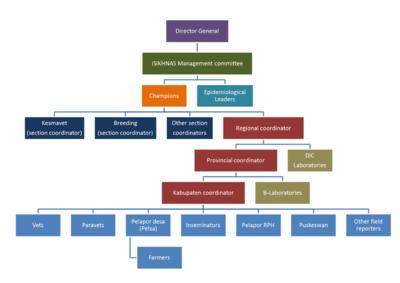How is it managed?: Perbedaan revisi
(→iSIKHNAS coordination and management model) |
(→How is iSIKHNAS managed?) |
||
| Baris 1: | Baris 1: | ||
==How is iSIKHNAS managed?== | ==How is iSIKHNAS managed?== | ||
| − | [[Image:iSIKHNAS management structure v1.png|iSIKHNAS Support and Management structure]] | + | [[Image:iSIKHNAS management structure v1.png|thumb|400px|iSIKHNAS Support and Management structure]] |
The management of iSIKHNAS is overseen by a committee of senior staff from various directorates general and subdirectorates. The committee is supported by the technical expertise from the system administrators or Champions and the Epidemiology Advisory group. | The management of iSIKHNAS is overseen by a committee of senior staff from various directorates general and subdirectorates. The committee is supported by the technical expertise from the system administrators or Champions and the Epidemiology Advisory group. | ||
| Baris 6: | Baris 6: | ||
Sections are represented by an appointed coordinator who is responsible for the oversight of the specialist activities such as abattoir reporting, breeding and production and quarantine for example. | Sections are represented by an appointed coordinator who is responsible for the oversight of the specialist activities such as abattoir reporting, breeding and production and quarantine for example. | ||
| − | Each administrative level will have a coordinator appointed and trained. So, each region, province and kabupaten will have a designated coordinator. Some areas may choose to share the coordination between two staff members to ensure that one person is burdened with too much responsibility. | + | Each administrative level will have a coordinator appointed and trained. So, each region, province and kabupaten will have a designated coordinator. Some areas may choose to share the coordination between two staff members to ensure that one person is not burdened with too much responsibility. |
| − | The most important roles are undertaken by the field staff - dinas vets and para-vets - and the village reporters (pelsa). These individuals are the source of most data and their continued collaboration is vital to the ongoing strength of iSIKHNAS. | + | The most important roles are undertaken by the field staff - dinas vets and para-vets, inseminators, field Kesmavet staff etc. - and the village reporters (pelsa). These individuals are the source of most data and their continued collaboration is vital to the ongoing strength of iSIKHNAS. |
Revisi per 2 Maret 2014 22.15
How is iSIKHNAS managed?
The management of iSIKHNAS is overseen by a committee of senior staff from various directorates general and subdirectorates. The committee is supported by the technical expertise from the system administrators or Champions and the Epidemiology Advisory group.
Sections are represented by an appointed coordinator who is responsible for the oversight of the specialist activities such as abattoir reporting, breeding and production and quarantine for example.
Each administrative level will have a coordinator appointed and trained. So, each region, province and kabupaten will have a designated coordinator. Some areas may choose to share the coordination between two staff members to ensure that one person is not burdened with too much responsibility.
The most important roles are undertaken by the field staff - dinas vets and para-vets, inseminators, field Kesmavet staff etc. - and the village reporters (pelsa). These individuals are the source of most data and their continued collaboration is vital to the ongoing strength of iSIKHNAS.

